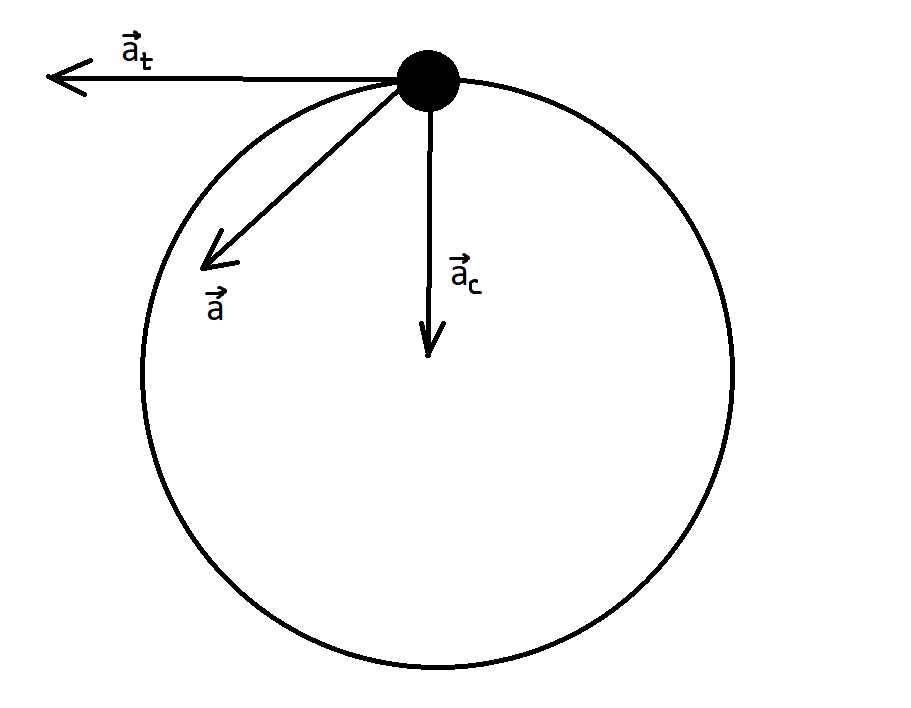
In a non-uniform circular motion, the ratio of tangential to radial acceleration is (r=radius of a circle, v=speed of the particle, $\alpha $= angular acceleration.
A. $\dfrac{{{\alpha ^2}{r^2}}}{v} $
B. $\dfrac{{{\alpha ^2}r}}{{{v^2}}} $
C. $\dfrac{{\alpha {r^2}}}{{{v^2}}}$
D. $\dfrac{{{v^2}}}{{{r^2}\alpha }} $
Answer
568.5k+ views
Hint: In non-ideal cases, the circular motion of a body will not have constant angular velocity but it will slow down or pick up pace regularly. The total acceleration of a body moving in a circular motion is the resultant of two types of accelerations, namely Centripetal and Tangential acceleration.
$\overrightarrow a = {\overrightarrow a _c} + {\overrightarrow a _t}$
Complete step by step answer:
Let us consider a non-uniform circular motion as shown below,

In a non-uniform circular motion, the body not only changes its angular velocity per unit time but also, the direction of the velocity vector. Since the velocity vector, which is a tangent to the direction of motion of the body, keeps changing every second, we get an additional component of acceleration. This component of acceleration is called Tangential acceleration.
Tangential acceleration, $\left| {{a_t}} \right| = r\alpha $
$\alpha $ is called the angular acceleration, which means the change in angular velocity in radians per second.
$\alpha = \dfrac{\omega }{t}$
There is one more component of acceleration, for the actual change in the velocity per unit time and is directed towards the center of the circle. This is called Centripetal acceleration. This is also called Radial acceleration.
Centripetal acceleration, $\left| {{a_c}} \right| = \dfrac{{{v^2}}}{r}$
The ratio of Tangential acceleration to Radial acceleration is,
$\Rightarrow \dfrac{{{a_t}}}{{{a_c}}} = \dfrac{{r\alpha }}{{\dfrac{{{v^2}}}{r}}}$
Simplifying, we get
$\Rightarrow \dfrac{{{a_t}}}{{{a_c}}} = \dfrac{{r\alpha \times r}}{{{v^2}}}$
$\Rightarrow \dfrac{{{a_t}}}{{{a_c}}} = \dfrac{{\alpha {r^2}}}{{{v^2}}} $
Thus, the correct option is Option C.
Note:
Sometimes, you may get confused while marking the directions of components of the acceleration. So, remember this fact.
Tangential acceleration will always be a tangent to the circle. Just like a tangent, it will touch the circle only at one point and will be perpendicular to the radius.
Centripetal acceleration will be directed towards the center because it has the centre of the words in it.
$\overrightarrow a = {\overrightarrow a _c} + {\overrightarrow a _t}$
Complete step by step answer:
Let us consider a non-uniform circular motion as shown below,

In a non-uniform circular motion, the body not only changes its angular velocity per unit time but also, the direction of the velocity vector. Since the velocity vector, which is a tangent to the direction of motion of the body, keeps changing every second, we get an additional component of acceleration. This component of acceleration is called Tangential acceleration.
Tangential acceleration, $\left| {{a_t}} \right| = r\alpha $
$\alpha $ is called the angular acceleration, which means the change in angular velocity in radians per second.
$\alpha = \dfrac{\omega }{t}$
There is one more component of acceleration, for the actual change in the velocity per unit time and is directed towards the center of the circle. This is called Centripetal acceleration. This is also called Radial acceleration.
Centripetal acceleration, $\left| {{a_c}} \right| = \dfrac{{{v^2}}}{r}$
The ratio of Tangential acceleration to Radial acceleration is,
$\Rightarrow \dfrac{{{a_t}}}{{{a_c}}} = \dfrac{{r\alpha }}{{\dfrac{{{v^2}}}{r}}}$
Simplifying, we get
$\Rightarrow \dfrac{{{a_t}}}{{{a_c}}} = \dfrac{{r\alpha \times r}}{{{v^2}}}$
$\Rightarrow \dfrac{{{a_t}}}{{{a_c}}} = \dfrac{{\alpha {r^2}}}{{{v^2}}} $
Thus, the correct option is Option C.
Note:
Sometimes, you may get confused while marking the directions of components of the acceleration. So, remember this fact.
Tangential acceleration will always be a tangent to the circle. Just like a tangent, it will touch the circle only at one point and will be perpendicular to the radius.
Centripetal acceleration will be directed towards the center because it has the centre of the words in it.
Recently Updated Pages
Master Class 11 Economics: Engaging Questions & Answers for Success

Master Class 11 English: Engaging Questions & Answers for Success

Master Class 11 Social Science: Engaging Questions & Answers for Success

Master Class 11 Biology: Engaging Questions & Answers for Success

Class 11 Question and Answer - Your Ultimate Solutions Guide

Master Class 11 Business Studies: Engaging Questions & Answers for Success

Trending doubts
10 examples of friction in our daily life

One Metric ton is equal to kg A 10000 B 1000 C 100 class 11 physics CBSE

Difference Between Prokaryotic Cells and Eukaryotic Cells

1 Quintal is equal to a 110 kg b 10 kg c 100kg d 1000 class 11 physics CBSE

State the laws of reflection of light

Explain zero factorial class 11 maths CBSE




